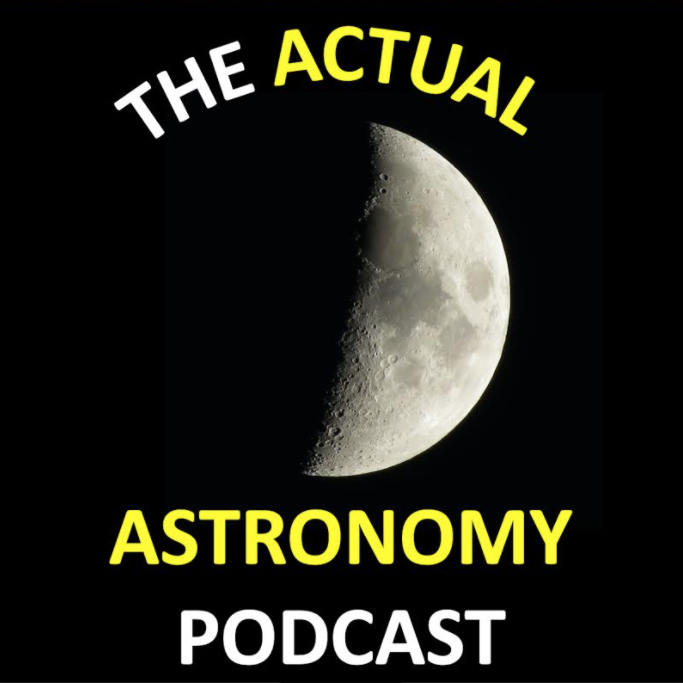Podcaster: Shane and Chris

Title: Actual Astronomy: Naked Eye Astronomy
Organization: Actual Astronomy
Link : https://actualastronomy.podbean.com/ ; https://www.deepskyeye.com/
Description: The Actual Astronomy Podcast presents Naked Eye Astronomy. In this episode we talk about the faintest thing you can see as well as the Milky Way, our Moon, Planets, the Belt of Venus, Crepuscular Rays, Heat Lighting, Noctilucent Clouds, Aurora and Comets.
Bio: Shane and Chris are amateur astronomers who enjoy teaching astronomy classes and performing outreach where they help the eyes of the public to telescope eyepieces.
Today’s sponsor: Big thanks to our Patreon supporters this month: Paul M. Sutter, Chris Nealen, Frank Frankovic, Frank Tippin, Jako Danar, Michael Freedman, Nik Whitehead, Rani Bush, Ron Diehl, Steven Emert, Brett Duane, Don Swartwout, Vladimir Bogdanov, Steven Kluth, Steve Nerlich, Phyllis Foster, Michael W, James K Wood, Katrina Ince, Cherry Wood.
Please consider sponsoring a day or two. Just click on the “Donate” button on the lower left side of this webpage, or contact us at signup@365daysofastronomy.org.
Please visit our Patreon page: https://www.patreon.com/365DaysOfAstronomy
or you can consider to sponsor a day of our podcast : https://cosmoquest.org/x/365daysofastronomy/product/sponsor-an-episode-of-365-days-of-astronomy/
Transcript:
Naked Eye Astronomy on Episode 471 of the Actual Astronomy podcast. I’m Chris and joining me is Shane. We are amateur astronomers who love looking up at the night sky and this podcast is for everyone who enjoys going out under the stars.
New Patreon supporters – Stephen V, Zachary, Richard S
cantonbecker.com – great digital astro calendar subscription
90mm Coronado etalon, T-Max tuner, adapter
I have some Thanks –
City Lights Books T-Shirt
Justin Eyepieces
Nagler Type 7s
Cleaning Package from Alister
Recent bouts of poor weather, I was up at the observatory stuffing holes as the temp is dropping to -40’s without the wind. It was -20C out and just -8C inside.
Email from Alister
This is my favourite Lucian Kemble quote. In Edmonton (western prairies Canada) we’re trying to introduce more newcomers to visual observing under the challenge of winter cloud and cold. Observing doesn’t have to be a deeply focused persnickety activity. It’s easy to get a smile from a simple twilight sky, the jump of the Moon from one night to the next, or the movement of the planets over a week.
The key is to simply pause for a real minute and take it in, with some slow inhales through the nose. As you look at Jupiter, see if it makes a straight line between Aldebaran and Capella or one of the other stars in the hexagon of Auriga. Within 3 or 4 nights its shift is obvious.
Another thing to check out is the phase of the Moon as it passes Jupiter. On March 5th it is at First Quarter, then on April 2nd it is a fat crescent, on the 30th, a classic crescent. A lunar orbit against the sky is 2 days shorter than the 29.5 days to repeat a phase.
So did I get some observing in while it was -25? You bet!
Happy skygazing everyone,
Alister.
P.S. I get a warm fuzzy reading “You can observe a lot just by watching!” because I can hear Lucian’s voice in my head.
About 6,000 stars are visible to the unaided eye and some even in the day
Eric Saw eta Cassiopeia in the Calgary Centre 14-inch they retrofitted
Milky Way – Walter Scott Houston – Shadows
What’s the faintest thing you can see?
Moon – TWS – Copernicus? Libration 15:32 Young Moon Record
Planets – Jupiter’s Satellites.
Belt of Venus
Crepuscular Rays / Heat Lighting / Noctilucent Clouds, Aurora
Comets
Concluding Listener Message: Please subscribe and share the show with other stargazers you know and send us show ideas, observations and questions to actualastronomy@gmail.com
365 Days of Astronomy
=====================
The 365 Days of Astronomy Podcast is produced by Planetary Science Institute. Audio post production by Richard Drumm, project management by Avivah Yamani, and hosting donated by libsyn.com. This content is released under a creative commons Attribution-NonCommercial 4.0 International license. Please share what you love but don’t sell what’s free.
This show is made possible thanks to the generous donations of people like you! Please consider supporting our show on Patreon.com/CosmoQuestX and get access to bonus content. Without your passion and contribution, we won’t be able to share the stories and inspire the worlds. We invite you to join our community of storytellers and share your voice with listeners worldwide.
As we wrap up today’s episode, we are looking forward to unravel more stories from the Universe. With every new discovery from ground-based and space-based observatories, and each milestone in space exploration, we come closer to understanding the cosmos and our place within it.
Until next time and let the stars guide your curiosity!

